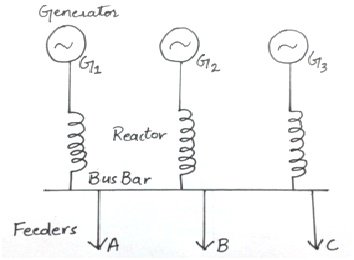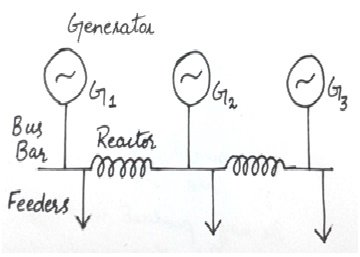In this article, we will explore the importance of reactors in a power system and discuss their various types and applications. Additionally, we will examine the advantages and disadvantages associated with using reactors in different locations within the power system, supported by informative diagrams.
Generator Reactors
A generator reactor is connected between the bus bar and the generator, and in some cases, it can be connected in series with the generator itself. When a new generator is added to an existing one, a reactor is introduced in series with the old generator to offer protection. The value of this reactor is determined by the impedance of the generator. Typically, the pu (per unit) value of the reactor should be around 0.05 or 0.06. Refer to the following figure for a visual representation:

Disadvantages:
- A fault occurring in one feeder can disrupt the supply of other feeders as well.
- After removing the faulty feeder, the generator must be synchronized again.
- During normal operation, the reactor experiences continuous power loss due to the full load current passing through it.
Feeder Reactors
Feeder reactors are vital components in power systems as they are connected in series with feeders. These reactors play a crucial role in mitigating the impact of short circuits that occur in feeders. Without feeder reactors, a fault in the nearest generating station could lead to a loss of synchronism among the connected generators and a decrease in the bus bar voltage.
Advantages:
- The voltage drop across a reactor during faulty conditions does not affect the voltage of the bus bar, thus minimizing the chances of losing synchronism.
- A fault on one feeder does not affect other feeders.
Disadvantages:
- Each feeder requires its own reactor, resulting in an increased number of reactors in the system.
- The size of the reactor needs to be increased if the number of generators in the system grows.
- The continuous power loss occurs during normal operation due to the full load current passing through the reactor.
To regulate proper voltages, reactors should be connected based on the power factor of the feeders. The feeder reactance is typically between 0.05 to 0.12 pu.
Bus Bar Reactors
Bus bar reactors are connected directly to bus bars, dividing them into smaller sections. When the voltage level remains the same, no current passes through these reactors, allowing each section to act as an independent bus bar. Should a fault occur in one section of the bus bar, the reactor shields the other sections from the fault’s impact, limiting the affected area. Therefore, a bus bar should be large enough to protect the system and maintain synchronism. An ideal reactor should drop the voltage by approximately 30 to 50% at full current. The reactance of a single bus bar reactor is recommended to be around 0.3 to 0.5 pu.
The following methods describe how to reduce continuous voltage drop and power losses in feeder and generator reactors:
1. Ring System
In this system, the bus bar is divided into sections, with each section connected to one another through a reactor. With separate generators supplying power to their respective loads, the ring system minimizes power losses in the reactors during normal operation.

2. Tie Bar System
The generators in the tie bar system are connected to a common bus bar through reactors, while the feeders receive power through the generator side of the reactors. This system is particularly effective for larger power systems. The reactance of the reactors in this configuration is half compared to the reactance in the ring system.

Advantages and Disadvantages
This system provides greater flexibility in terms of switch gear efficiency without requiring modifications to the overall system. However, it is a complex system that necessitates an additional bus, known as the tie bar.
Shunt Reactors
Shunt reactors are connected between phases or between a phase and neutral. Their purpose is to compensate for the effect of line capacitance in long transmission lines.

Neutral Reactors
Neutral reactors are used to ground the neutral terminal of a power system. In the event of a single-phase-to-ground fault, these reactors provide a pathway for the current. Peterson coil is an example of a neutral reactor. Under normal conditions, no current passes through this reactor. Neutral reactors are typically used in systems below 70kV.

By understanding the significance of reactors and their various applications in the power system, we can ensure the effective and efficient operation of electrical networks.
Role of Reactors in Power System
Reactors play a crucial role in power systems by serving various functions that enhance the reliability, stability, and efficiency of the overall system. Some of the key uses of reactors in power systems include:
Voltage Regulation: Reactors can be used to regulate and control voltage levels in the power grid. By adjusting the reactance of the reactors, voltage fluctuations can be mitigated, ensuring a consistent and reliable supply of electricity.
Line Loss Reduction: Reactors are employed to counteract the effects of line capacitance, which can lead to reactive power losses in transmission lines. By adding reactors, the reactive power flow can be balanced, reducing losses and improving overall transmission efficiency.
Short Circuit Current Limiting: Reactors can be designed to limit the magnitude of short circuit currents during faults. This helps protect equipment from damage and prevents rapid voltage drops that could disrupt the stability of the system.
Harmonic Filtering: Reactors can act as passive filters to reduce the levels of harmonic currents and voltages in the power system. This is especially important in systems with a high penetration of non-linear loads, such as industrial equipment and electronic devices, which can introduce harmonic distortions.
Series Compensation: Reactors can be used in series compensation schemes to control power flow and voltage profiles in long transmission lines. This is particularly useful for optimizing power transfer capabilities and improving voltage stability.
Fault Current Limiting: In the event of a fault, reactors can help limit the fault current magnitude, reducing the stress on protective devices and minimizing damage to the power system components.
Noise Reduction: Reactors can attenuate high-frequency transient noise caused by switching operations or lightning events, thus improving the quality of the power supply.
System Resonance Mitigation: Reactors can be strategically placed to dampen unwanted system resonances that can lead to voltage instability or even equipment damage.
Voltage Flicker Mitigation: By controlling reactive power flow, reactors can help mitigate voltage flicker, which can affect the performance of sensitive equipment.
Power Factor Correction: Reactors can contribute to power factor correction by controlling reactive power flow and maintaining a desired power factor level, which helps optimize energy efficiency and reduce reactive power charges.
In essence, reactors act as vital tools for managing various aspects of power system operation and maintaining a stable and reliable electricity supply.
Conclusion
In conclusion, reactors are indispensable components of power systems, playing a vital role in ensuring the reliable and efficient operation of electrical networks. From generator reactors to feeder reactors, bus bar reactors to shunt reactors, each type serves a specific purpose in enhancing voltage regulation, reducing line losses, limiting short circuit currents, filtering harmonics, compensating for power flow, and mitigating system resonances. Reactors contribute to the stability, reliability, and overall performance of the power system, ultimately providing a consistent and high-quality supply of electricity. By understanding the significance of reactors and their various applications, we can optimize power system operation and pave the way for a resilient and sustainable energy future.
This was insightful, thank you very much.